日本饮食文化介绍(英文ppt)
日本饮食文化介绍 英文
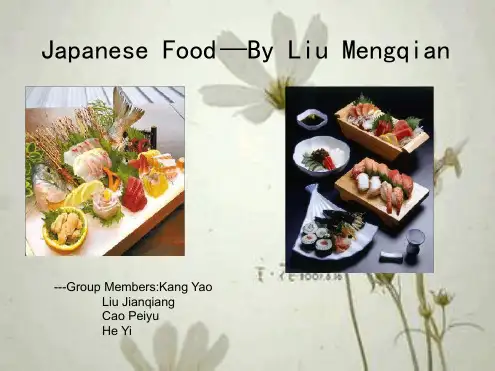
The funa sushi is said to be the most famous and typical sushi.
5:Sashimi
? Sashimi is a Japanese delicacy primarily consisting of very fresh raw seafood, sliced into thin pieces about 2.5cm wide by 4cm long by 0.5cm thick, but dimensSiaoshnimsi vary depending on the type of item and chef, and served with only a dipping sauce, depending on the fish.
Japanese Food —By Liu Mengqian
---Group Members:Kang Yao Liu Jianqiang Cao Peiyu He Yi
? The staple of the Japanese diet is rice.Rice and miso soup has been common breakfast foods. There are also many people who eat Mbisroesaoudp for breakfast.
3:Buckwheat Noodles
? Buckwheat noodles or soba is also a typical Japanese dish. There are some people that eat soba at least once a day. Many office workers make it a habit to have soba for lunch. Soba noodles are a mixture of buckwheat, flour and eggs. It looks similar to spaghetti in shape. It is first boiled, and then dipped in a soup made of soy sauce, salt, sweet sake, and bonito shavings when it is being eaten. Because soba is long, it is considered a symbol of long life.
用英语介绍日本美食
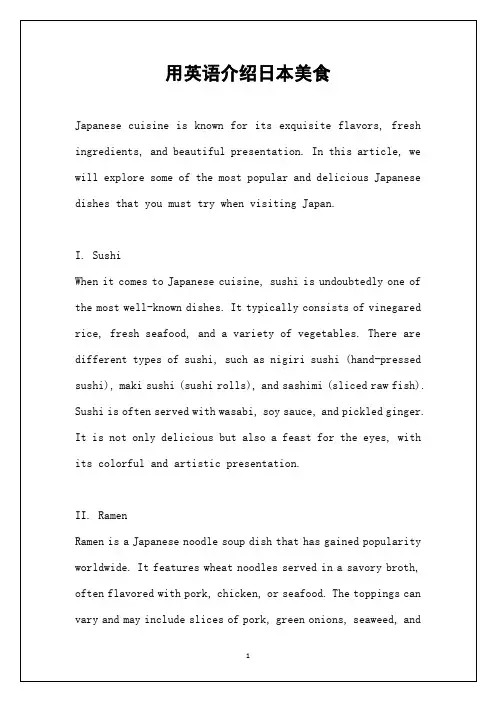
Ramen is a Japanese noodle soup dish that has gained popularity worldwide. It features wheat noodles served in a savory broth, often flavored with pork, chicken, or seafood. The toppings can vary and may include slices of pork, green onions, seaweed, anda boiled egg. Each region in Japan has its own unique style of ramen, so be sure to try different variations when traveling around the country.
III. Tempura
Tempura is a classic Japanese dish that consists of seafood, vegetables, or mushrooms that are battered and deep-fried to perfection. The result is a light and crispy texture that perfectly complements the natural flavors of the ingredients. rved with a dipping sauce and a side of grated daikon radish.
I. Sushi
When it comes to Japanese cuisine, sushi is undoubtedly one of the most well-known dishes. It typically consists of vinegared rice, fresh seafood, and a variety of vegetables. There are different types of sushi, such as nigiri sushi (hand-pressed sushi), maki sushi (sushi rolls), and sashimi (sliced raw fish). Sushi is often served with wasabi, soy sauce, and pickled ginger. It is not only delicious but also a feast for the eyes, with its colorful and artistic presentation.
日本文化传统英文介绍
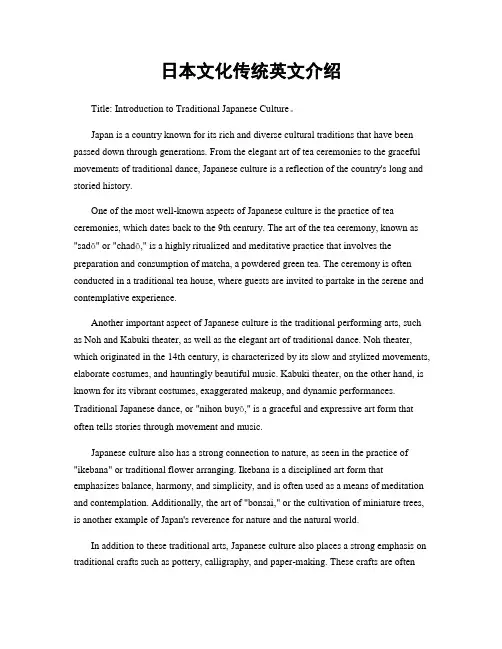
日本文化传统英文介绍Title: Introduction to Traditional Japanese Culture。
Japan is a country known for its rich and diverse cultural traditions that have been passed down through generations. From the elegant art of tea ceremonies to the graceful movements of traditional dance, Japanese culture is a reflection of the country's long and storied history.One of the most well-known aspects of Japanese culture is the practice of tea ceremonies, which dates back to the 9th century. The art of the tea ceremony, known as "sadō" or "chadō," is a highly ritualized and meditative practice that involves the preparation and consumption of matcha, a powdered green tea. The ceremony is often conducted in a traditional tea house, where guests are invited to partake in the serene and contemplative experience.Another important aspect of Japanese culture is the traditional performing arts, such as Noh and Kabuki theater, as well as the elegant art of traditional dance. Noh theater, which originated in the 14th century, is characterized by its slow and stylized movements, elaborate costumes, and hauntingly beautiful music. Kabuki theater, on the other hand, is known for its vibrant costumes, exaggerated makeup, and dynamic performances. Traditional Japanese dance, or "nihon buyō," is a graceful and expressive art form that often tells stories through movement and music.Japanese culture also has a strong connection to nature, as seen in the practice of "ikebana" or traditional flower arranging. Ikebana is a disciplined art form that emphasizes balance, harmony, and simplicity, and is often used as a means of meditation and contemplation. Additionally, the art of "bonsai," or the cultivation of miniature trees, is another example of Japan's reverence for nature and the natural world.In addition to these traditional arts, Japanese culture also places a strong emphasis on traditional crafts such as pottery, calligraphy, and paper-making. These crafts are oftenpassed down through families and communities, and are valued for their beauty, precision, and connection to the past.Overall, traditional Japanese culture is a reflection of the country's deep respect for history, nature, and the arts. From the serene beauty of tea ceremonies to the vibrant performances of traditional theater, Japan's cultural traditions continue to inspire and captivate people around the world.。
日本饮食文化 ppt课件
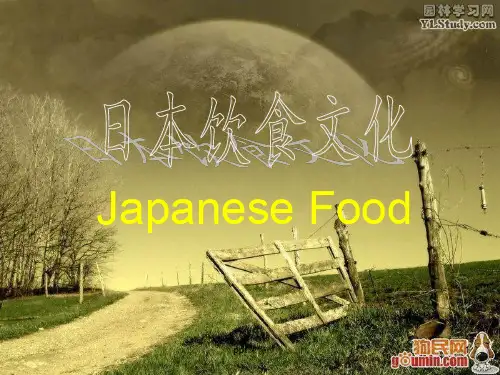
生、煮、烤、炸、蒸。而品尝日本料理的准则在于香、丰、
熟、甘、嫩。由于日本菜强调的是卖相和质感,所以每份
菜的量通常很少,但原料的素质却无与伦比。他们最强调
的是材料新鲜、刀工讲究、摆放艺术 。日本料理的种类
很多 ,比较有名的料理有:怀石料理,卓袱料理,茶会
料理,修行料理,会帮料理。
ppt课件
8
怀石料理。按照
ppt课件
6
日本人的三餐大体可归纳如下:
•
一、早餐:普通的日式早餐通常是,一个鸡蛋(50g),一碗米
饭(100g),1块烤鱼(50g)或火腿肠(50g),一盘蔬菜与水果 (150~200g),一小碟咸菜,一碗酱汤。当然也有一部分人,尤其是 年轻人,习惯于西式早餐,往往是一片面包涂上黄油或果酱,一杯牛 奶(300~400ml)或果汁、咖啡。
ppt课件
10
茶会料理。日本的室
町时代(14世纪)盛行茶道,于是出现
了茶宴茶会料理。最初的茶会料理只是
茶道的点缀,十分简单。到了室町末期,
变得非常豪华奢侈。其后,茶道创始人
千利休又恢复了茶会料理原来清淡素朴 的面目。
ppt课件
11
修行料理:修行料理又叫
“精进料理”,意思是吃斋、吃素。选料有荞 麦面、豆腐、腌菜、炸虾等。其实,所谓的
日本人喜欢食用纳豆。他们主要食用咸纳豆与拉丝纳 豆,关西人喜欢前者,关东人则爱吃后者。拉丝纳豆由于 发酵方法不同,而出现一种黏丝,是不放盐的。作。”纳 豆初始于中国的豆豉”。
ppt课件
16
ppt课件
17
• 寿司是日本传统日本食品,主要材料是用醋调味过的
冷饭(简称醋饭),再加上鱼肉、海鲜、蔬菜或鸡蛋等作 配料。既可以作为小吃也可以作正餐,花色种类繁多。配 料可以是生的、也可以是熟的,或者腌过的。
日本饮食文化ppt课件

寿司的做法:
原料:米,醋,鱼。
(1)把煮好的饭打松,将寿司醋均匀地淋在饭上,拌匀。不要压饭粒, 尽量保持饭粒的完整,松软。 (2)把一张紫菜放在寿司席上,由左至右将饭铺好。将饭由上至下均匀的铺开,用力 要轻。饭要铺的松,不要压扁饭粒,这样吃起来口感才会好! 可以在中间放入任何 自己喜欢的馅,好吃就行。之后顺势用竹帘将紫菜卷起。 还要用竹帘将其卷起保持 形状1分钟 。切寿司的时候,在刀上沾些水,防粘的。
中食优于日食!
江户时代:这个时代是武士掌权的时代,料理的发展受到 (町人文化)社会上士农工商的文化及习性影响很大。然 而,在此时代,各种类的料理再重新整合,更进步的发展 成为日本料理集大成的时代。
明治以后:这个时代,由於明治维新的西化,文 明开化,西洋料理的急速进入,使日本人的饮食 生活有了很大的改变及影响;因而演变成为强调 自由自在的个人口味倾向,而且不同文化的交流, 产生了日本料理流通性、变化性过於广大的优点 也是缺点。
日本饮食的发展过程:
古代:食材以谷类为主,鱼贝类、 海藻类、蔬菜、鸟兽肉类等。而其 中种类繁多,有些鸟兽肉类却由於 佛教的东传以后,基於原则及其方 针而变成为不食用;先前的蔬菜及 海产类等食材,从古代经平安时代 至今,使用上无很大的变化。
平安时代:这个时代里,与(中国)的交流频繁,所产生 的结果是古代的食物烹调法中,有了各式各样新的技法加 入,而且在飨应膳及年中行事(重要节日)上所须用到的 基本餐形及食物也都得到确定,而成为日本料理的基础。 此时代中,使用面粉制作馒头及煎饼此类的中国式点心; 运用芝麻来榨油,并且用於油炸食物及其他食品的加工上; 另外,渍物(腌渍类食物)及蒲鉾(日本鱼浆类食品)等 类食品,也在此时代里建立了基础。
用餐方式:
用餐前后 :日本人在用餐之前及之后都要高声表达两种感受, 用餐前要说 “Itadkimasu!”,意思是欣赏这顿饭食;用餐后 要说 “Go-chiso-samadeshita!”,意思是感谢款客者预备这 顿极美味的饭食。
【全面版】英文 介绍日本文化PPT文档
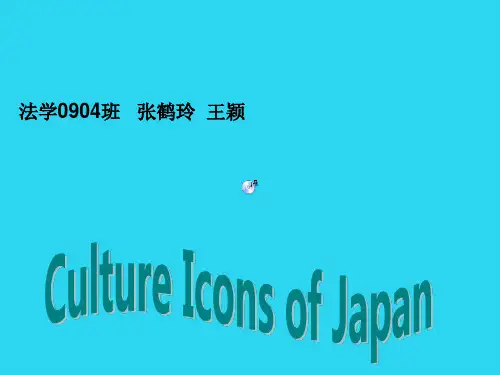
In Japanese, the cherry is called ”Sakura”, which is generally believed to be a corruption of the word “ Sakura” (blooming ) from the name of Princess KonoHana-Sakura-Hime.
There is often a misconception(误解) by some that Geisha are prostitutes(娼妓), but nothing could be further from the truth Geisha are refined and cultured girls and woman who are highly trained in a variety of traditional skills. Besides playing Shamisen ( 三弦琴), singing, and dancing, the Geisha perform the Japanese tea ceremony, and are well versed(精通的) in the art of conversation. Many learn to speak English to entertain Western guests.
This Mt. Fuji is beautiful and magic, isn’t it?
Many learn to speak English to entertain Western guests. In Japanese, the cherry is called ”Sakura”, which is generally believed to be a corruption of the word “ Sakura” (blooming ) from the name of Princess Kono-Hana-Sakura-Hime. Maneki Neko Located almost in the center of the country, this well-proportioned cone-shaped mountain has been worshiped by the Japanese people since ancient times, and is a well-known symbol of Japan in other countries. The scroll he carries bears the congenial(和蔼的) message. With a right paw raised he welcomes wealth or luck. Maneki Neko 法学0904班 张鹤玲 王颖 There is often a misconception(误解) by some that Geisha are prostitutes(娼妓), but nothing could be further from the truth Geisha are refined and cultured girls and woman who are highly trained in a variety of traditional skills. Welcoming Cat, Lucky Cat, Money cat , Fortune Cat Many learn to speak English to entertain Western guests. With economic, cultural and religious influence from neighboring Asian states, Japan has produced a unique culture of its own. 法学0904班 张鹤玲 王颖 法学0904班 张鹤玲 王颖 Located almost in the center of the country, this well-proportioned cone-shaped mountain has been worshiped by the Japanese people since ancient times, and is a well-known symbol of Japan in other countries. “Maneki Neko” means “beckoning(召唤) cat” in the Japanese language. With economic, cultural and religious influence from neighboring Asian states, Japan has produced a unique culture of its own. Fuji, however, soars into the sky alone.
日本拉面 英文PPT
Ramen
The origin of ramen
• origins in China • was imported to Japan during the Meiji Period(明治时代)(1868-1912) and then Japanized
Make a delicious ramen
Thank you ! (ありがとうございます)
Ramen in China
• Ajisen(味千拉面) • "White Soup", (made from bones, meat bones, pig bones and various kind of fish bones)
Today's ramen
• using robots as Ramen chefs • "The benefits of using robots as Ramen chefs include the accuracy of timing in boiling noodles, precise movements in adding toppings and consistency in the taste." • "I don't feel any difference in taste between this ramen and those cooked by human chef."
• Chukamen(中华面) noodles which are generally made with wheat flour and kansui (alkaline solution) are used for bone, pork bone, dried sardines(沙丁鱼干), and kombu(海带) • Vegetables, such as ginger, negi onion, garlic, or mushrooms
日本拉面 英文PPT
(ラーメン,日本拉面)
Ramen
The origin of ramen
• origins in China • was imported to Japan during the Meiji Period(明治时代)(1868-1912) and then Japanized
• Chicken bone, pork bone, dried sardines(沙丁鱼干), and kombu(海带) • Vegetabon, garlic, or mushrooms
Ramen in China
• Ajisen(味千拉面) • "White Soup", (made from bones, meat bones, pig bones and various kind of fish bones)
Thank you ! (ありがとうございます)
Cup Noodle Museum 杯面博物馆
• There is a unique museum for ramen opened by Japanese food company Nissin (日清食品株式会社) in Yokohama (横滨). • be able to make their own cup noodles out of 5,460 choices
Make a delicious ramen
• Chukamen(中华面) noodles which are generally made with wheat flour and kansui (alkaline solution) are used for ramen dishes.
日本食物英文版PPT课件
18
How to roll maki-zushi
2021/3/12
19
Japanese Cuisine
• Suyaki—beef • Fugu—puffer fish, delicacy • Tofu and Natto--soybeans • Tempura • Noodles • Pickles and Preserved Seafood
2021/3/12
15
Sashimi—Cuisine not cooked
• Japanese philosophy: “Food should be enjoyed as close as possible to natural state”
• Sashimi—raw fish
• Raw -> Grill -> Simmer, depending on freshness of fish
• Japanese differ from Chinese • Made of lacquered wood • Women and children have smaller
chopsticks
2021/3/12
11
Chopstick etiquette
• Breaches of etiquette: • Clutched, Piercing, Scooping, Cramming,
• 1958 Japan forced to trade with US, Britain, France, Netherlands, and Russia
• Raw silk and tea
• Contact with Western culture adoption of meat into cuisine
介绍日本传统文化-英语PPT
TIP3:THE TEA CEREMONY ETIQUETTE
Japanese Zhu product Zhu is very exquisite plac e, a were held in the room every time huan, wan g will be in the first Qian chamber activities outs ide the grid kneel down to meet the guests, the first guests into Du room must be a Cha Mu sea t guests (referred to as positive guest), the other guest barium eternal happiness down room..To attend a guest treedwelling Du things different, were sitting position is different when Du testers to send "tut" sound, said to the Lord, and Du "private. After the breeding, the rest of t he guests will be able to drink it one by one, an
LASTLY
THANKS FOR WAtraditional Japanese manners.
Terms:陈力 杨运冬 刘美阳 黄润德 熊 海福 韩国庆
TIP1:MANNERS
OF KNEEL
In Japan, the guests sit in the traditional way on their knees on the floor. Japanese girls accept etiquette education. Its strict requirements even detailed formal shoes placement, socks color and so on.
- 1、下载文档前请自行甄别文档内容的完整性,平台不提供额外的编辑、内容补充、找答案等附加服务。
- 2、"仅部分预览"的文档,不可在线预览部分如存在完整性等问题,可反馈申请退款(可完整预览的文档不适用该条件!)。
- 3、如文档侵犯您的权益,请联系客服反馈,我们会尽快为您处理(人工客服工作时间:9:00-18:30)。
The funa sushi is said to be the most famous and typical sushi.
5:Sashimi
• Sashimi is a Japanese delicacy primarily consisting of very fresh raw seafood, sliced into thin pieces about 2.5cm wide by 4cm long by 0.5cm thick, but dimensSiaoshnimsi vary depending on the type of item and chef, and served with only a dipping sauce, depending on the fish.
3:Buckwheat Noodles
• Buckwheat noodles or soba is also a typical Japanese dish. There are some people that eat soba at least once a day. Many office workers make it a habit to have soba for lunch. Soba noodles are a mixture of buckwheat, flour and eggs. It looks similar to spaghetti in shape. It is first boiled, and then dipped in a soup made of soy sauce, salt, sweet sake, and bonito shavings when it is being eaten. Because soba is long, it is considered a symbol of long life.
6:Soybean Curd
It uses the egg as the main raw material,supplemented with water, plant protein and natural seasoning.
with its high quality, delicious, nutrition, health, convenience and value for money ,it enjoys high reputation among consumers
2:Sukiyaki
• Sukiyaki is one of the representative foods of Japan. The name comes from the farmer’ spade sometimes used to cook on. Sukiyaki refers directly to broiling on the spade, along with soybean curd, leeks, and vegetables. The seasoning includes soy sauce , sweet sake, and sugar.
Japanese Food—By Liu Mengqian
---Group Members:Kang Yao Liu Jianqiang Cao Peiyu He Yi
• The staple of the Japanese diet is rice.Rice and miso soup has been common breakfast foods. There are also many people who eat Mbisroesaoudp for breakfast.
Buckwheat Noodles
Buckwheat Noodles
4:Sushi
• In Japanese cuisine, sushi is vinegared rice, usually topped with other ingredients, including fish, various meats, and vegetables. Funa sushi
First:Tempura
1:Tempura
• This dish mostly consists of deepfried eggplant, squash, sweet potato, and other vegetables, along with shrimp and fish. One theory is that the word tempura came from the Spanish tempera, meaning temperature. Tempura is eaten with a special soy sauce-based dip.
• Japanese food mostly consists of fish instead of meat, and also soybeans, so it is good for the health. Foods that are most well received by foreigners are tempura, sukiyaki, sushi, sashimi, buckwheat noodles and soybean curd.
